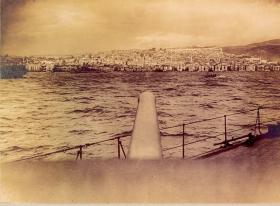Salonika
Published in 20th-century / Contemporary History, Issue 2 (Mar/Apr 2007), Letters, Letters, Volume 15, World War I
Salonika viewed from the deck of a British battleship. (Imperial War Museum)
Sir,
—I read with great interest the article by Alice McDermott and Mark Power on the 10th (Irish) Division in Salonica in 1915–17 (HI 14.6, Nov./Dec. 2006), and it is good to see recognition of Irish participation on this forgotten front of World War I. However, I do take issue with their assertion of an imperialist and bullying attitude by the British Salonica Force towards Greece and the Greeks.
The background to the deployment of British troops at Salonica (Thessaloniki) was intimately tangled in the complexities of Greek politics. Southern Macedonia (Makedhonia) and Salonica were prizes of the First Balkan War of 1912–13 when, with Bulgaria, Montenegro and Serbia, Greece defeated Turkey to liberate the Balkans. In June 1913 Greece signed a mutual defence treaty with Serbia, reaffirmed at the outbreak of World War I. Architect of the treaty and the earlier Balkan alliance was liberal republican Prime Minister Elefterios Venizelos (1864–1936). In 1914 Venizelos also offered an alliance to Britain and France, much against the wishes of the Greek king, Constantine I, married to a sister of Kaiser Wilhelm II of Germany and determined to maintain a state of neutrality—one distinctly biased towards Germany. Even before Bulgaria entered the war in November 1915, Venizelos pressured the king to mobilise the Greek army, whilst inviting the western allies to send an expeditionary force to Salonica, ostensibly in support of Serbia. The king dismissed Venizelos, who retreated to his native Crete and proclaimed revolution. In October 1916 he landed at Salonica, consolidated his support and, in June 1917, returned to Athens as prime minister. On 2 July his government declared war on the Central Powers. Greek soldiers joined the Salonica front in May 1918, and later contributed considerably to the final offensive that resulted in Bulgaria’s capitulation on 30 September.
It is hardly surprising that the allied soldiery were sometimes dismissive of their Greek hosts, since the 1915–17 royalist government (which treacherously ceded the key frontier fort of Rupel to the Bulgarians) was so very hostile and espionage was rife. Conversely, admiration for the Serbs derived both from their terrible retreat in the winter of 1915–16 across the mountains of Kosovo and Albania to Corfu, and their courageous and bloody storming in September 1916 of entrenched Bulgarian and German positions on the 2,400-metre summit of Mount Kajmakçalan.
Although, as McDermott and Power point out, the Irish soldiers put much effort into building roads and growing food as well as fighting, their 1917 departure to Palestine seems to have robbed them of more relaxing activity during the period between late autumn 1916 and late summer 1918 when the front was largely static. There is a fascinating archive of pressed plant specimens at the Natural History Museum in London, collected mostly in spring 1918 around Salonica by British military personnel. This gentle activity may have been an exercise in alleviating boredom—or a ploy to take minds off more worldly pleasures. In Salonica and after (Hodder and Stoughton, 1919) by H. Collinson Owen, editor of The Balkan News, daily newspaper of the British Salonica Force, the author notes how exuberant Tommies, poilus and their officers frequented a noisy array of ‘cafés, cabarets, café chantants, cinemas and music halls . . . Salonica’s bastard Montmartre!’
My own copy has a link with the Irish at Salonica. According to an ink inscription inside, it formerly belonged to ‘Major & temp. Lt-Col. A.G. Moutray, 1st The Connaught Rangers, Q. Staff G.H.Q, B.S.F. 1918–19’. A more tenuous personal link with those times came to me via the late David Webb, Professor of Botany at Trinity College, Dublin, who remembered as a young man seeing Mr Venizelos in kepi and Cretan cloak and tall boots on board a ferry-boat on Lake Garda in northern Italy shortly before his death. That wily old politician, who so managed the situation in Salonica for his country’s and his own strategic ends, had gone a step too far in support of a recent failed coup and so would die in exile. He is buried on Crete, where his memory is still much revered.
Dr JOHN AKEROYD
Salisbury
















